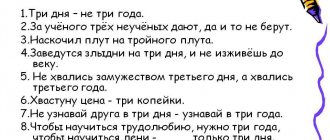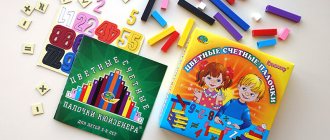You can start getting acquainted with the number 9 in an unusual way. Offer your child riddles, sayings, proverbs, puzzles, tongue twisters, poems, etc. For children who go to 1st grade, a presentation dedicated to the number 9 will be interesting. It is possible to interest a child in learning, but this will require effort.
Introducing numbers and numbers
Nine is the last digit in a series of single digit numbers. Acquaintance with it should occur when the previous eight have already been studied.
Before moving on to studying nine, you need to repeat and consolidate the material you have covered, solve examples on adding and subtracting single-digit numbers.
The child must know the answer to the question: what is the difference between a number and a digit and how many digits there are.
The lesson is conducted in an interactive form, using the following materials:
- educational games;
- puzzles;
- puzzles;
- Proverbs and sayings;
- simulators for the development of thinking, etc.
To make it comfortable for a child to study and easier to assimilate information, it is necessary to create an environment suitable for learning, eliminating extraneous sounds (TV, phone, tablet, etc.). You should create a working atmosphere in the room. It is not advisable to conduct a lesson in a children's room, where there are many toys and other elements that distract attention.
It is better to sit at a table in a large, bright room. During the lesson, you need to take short breaks and engage in physical activity during this time. This is due to the fact that a preschool child gets tired quickly and it will be difficult for him to sit in one position for a long time.
During the lesson, the child must master writing the number nine, learn how to perform arithmetic operations with it, concentrate attention on an object and complete tasks independently.
As educational material you can use:
- training video;
- books on mathematics for preschoolers;
- interactive maps;
- copybooks, coloring books;
- computer games.
The material should be presented in such a way as to interest the child. This is due to the fact that children cannot concentrate on what is not interesting to them. Perseverance and attentiveness must be developed gradually.
After the lesson, the child should:
- know the composition and formation of the number 9;
- be able to correlate the number of objects and objects with the number;
- be able to break a number into its components.
Searching for associations to facilitate understanding
To make it easier for a child to learn and remember nine, you need to make a series of associations with familiar objects and phenomena. Poems and pictures with the number 9 will help with this.
You should draw the child's attention to the fact that 9 looks like an inverted six.
You can also draw a parallel between nine and the letter D. Thus, the child will quickly remember not only numbers, but also letters.
Examples of what a 9 is like include:
- comma;
- elephant head with trunk;
- half a pretzel;
- a ball of thread;
- fish caught on a hook;
- seahorse;
- number 0 with a tail;
- open lock;
- ear;
- earring, etc.
Thanks to associative thinking, the memorization process is greatly facilitated.
Summary of a lesson in mathematics “Number 9, figure 9” (1st grade, educational complex “School of Russia”)
Lesson topic: “Number 9, number 9”
The purpose of the lesson:
— Creating conditions for the formation of a conceptual image.
— Introduce the number 9, determine the place of the number on the number line and the composition of the number 9.
— Introduce the number 9 and learn how to write it.
— To develop in children the ability to analyze and synthesize, the ability to independently choose a solution,
- Develop the ability to self-control,
— Learn to correctly explain your choice.
— To instill in children a desire for knowledge and the ability to do work independently.
— Learn to accept suggestions and assessments from a teacher or peer, negotiate and come to a common decision in joint activities.
— Practice the skill of working with the PervoLogo computer program.
— Use sign-symbolic means to solve assigned problems.
— To create interest in learning, to promote the development of the role of a student.
— Form of delivery: lesson.
— Forms of organizing joint activities: frontal work, work in the PervoLogo computer environment.
— Equipment: cards for working on the order of numbers, cards for tasks on the composition of numbers, an interactive album for each child’s PC, compiled using the PervoLogo program.
— Technical equipment: computer, multimedia overhead projector, interactive board.
DURING THE CLASSES
ORGANIZATION. Finger gymnastics “Good morning, eyes! You woke up?"
Good morning, little eyes! Are you awake? (Stroke your eyes with your index fingers, make “binoculars” out of your fingers, look into them)
Good morning, ears! Are you awake? (Stroke your ears with your palms, put your palms to your ears - “Cheburashka”)
Good morning, hands! Are you awake? (Stroke first one or the other arm, clap your hands)
Good morning, legs! Are you awake? Stroking your knees, stomping your feet)
Good morning, sun! I woke up! (Raise your hands up, look at the sun)
KNOWLEDGE UPGRADING. - We will now do exercises that will help us find out what we will be learning about today.
There are cards on your table.
Now those who have blue cards with the answer to the task will come to the board.
With this figure we denote a number that, when counting, stands between the numbers 2 and 4? Which number is 1 less than 2? Which number precedes the number 7 when counting? Which number is 2 greater than 6? Which number in the number series is to the right of number 6? How many corners does a square have? How many corners does a square have if one is sawed off? You, me, and you and me. How many of us are there? - Look at the numbers.
- In what order are they standing? (In a mess)
- In what order can they be put? (Ascending or Descending order)
- Please stand in ascending order.
- Let's now check if the guys completed the task correctly.
- What opinions will you have?
- And now we find out the correct answer. To do this, turn the numbers over. Read what word you came up with. (Well done...)
- Why didn’t you get the word? (One letter missing)
-What number will this letter be designated by? (9)
3. DETERMINING THE TOPIC OF THE LESSON.
- Who has already guessed what the topic of today's lesson is?
- Why did you decide so? (A new number has appeared, which we do not yet know how to write and do not know its composition)
4. DISCOVERY OF NEW KNOWLEDGE.
Learning to write the number 9.
- Let's put the number in its place on the number tape.
- Now let's learn how to write this number.
Working with the Number Tape
- Guys, I’m now holding in my hands another number 9. Where do we attach it on the number line? (Let's put it in the same place where the number 9 already stands)
- How did you find out? (We compared these numbers)
Comparison of the number 9
- Let's now compare the number 9 with other numbers. Open the Lesson No. 9 program in the PervoLogo program. Insert the desired comparison sign instead of asterisks. (All signs are drawn)
EXAMINATION
Self-test from the board.
— Why didn’t you put a comparison sign in the last entry? (Since an expression is written here in which the action sign is missing.)
Print this sign.
- What is the name of this expression? (Sum)
5. PHYSICAL MINUTE
- Please stand by the desks. Now I will name the sums, and you verbally find the result of this sum and make as many tilts to the right or left (alternately), which is equal to the result of the calculations. I will do these bends with you. But if I am wrong, you will have to correct me by explaining what my mistake is.
1+8 8+1 2+7 2+7 7+2 3+6 6+3 4+5 5+4
- Sit down please.
- Tell me how all the examples that we just solved are similar. (These were the amounts with answer 9)
6. WORK ON NUMBER COMPOSITION
— In front of you are cards with written expressions. Name them in one word in chorus. (sum)
- Now those who have a written sum of numbers equal to 9 will come to the board.
- Now try to put the cards in pairs.
- Let's all think about solving this problem together. (The pairs will contain sums where the same numbers have only changed places when added. It is important to arrange the cards so that the guys are neighbors on the desk.)
- Thank you! Now take your friend's hand and sit down in your seats.
7. CONFIRMING THE COMPOSITION OF THE NUMBER 9
- Let's now populate the house with all the numbers that helped us write down the sums with the answer 9. (Children work by dragging numbers into the windows of the house)
- So: 9 is 1 and 8, 9 is 8 and 1, etc.……… (Guys can name these examples in any order)
— Open the next page of our album. Here are the examples that we have compiled just now.
Under each column there are two expressions for subtraction and differences.
— What differences can be made using the numbers in the upper examples. (The work is carried out frontally. The teacher works with a PC with access to the screen. Then the teacher hides his recording.
8.INDEPENDENT WORK
- Take the numbers and action signs out of the baskets and insert the numbers into the missing cells.
SELF-CHECK FROM THE BOARD
- Who made mistakes? How did you fix them?
9. SOLVING PROBLEMS.
— How can you figure out what the notes between the drawings mean? (These are expressions in which signs are missing.)
- Using a pencil, try to restore these signs.
- Can we say that these expressions are solutions to the problems depicted in the form of a picture? (Children explain what and why)
- Let's try to establish correspondence between them.
— Connect the drawings with the solution to the problem (Children
At first they work independently, and then undergo a frontal check)
- Which task has 2 recording forms? (Children explain that on the left and by dragging the numbers, they make a new entry)
10. RESULT OF THE LESSON.
— What discoveries did you make in class today?
— What did you especially succeed in today?
Now choose the emoticon that best matches your mood in class. Cut out the rest with scissors. You can clear the page and draw your own emoticon - mood.
Simple problems for numerals
Simple tasks for preschoolers will help them master new material:
- There were 6 puppies in the booth. Then 3 more puppies were brought there. How many puppies are there in the kennel?
- Small houses are drawn on a piece of paper. Some of them have numbers and others don't. You need to return the missing signs to the houses by writing them in the correct field.
- The following examples need to be solved: 8+1, 5+4, 6+3, 7+2.
- Sveta had 3 pencils in her box. Zhenya gave her 6 pencils. How many pencils did Sveta have in her box?
- There were 9 ripe pears hanging on the tree. Maxim picked 2, mom took 3 for the pie. How many pears are left on the tree?
- The children picked 8 red tomatoes and 1 green one from the garden. How many tomatoes did the children collect?
Strengthening trainers
To consolidate the material covered, you need to practice a lot. Special simulators for improving writing skills will help with this:
- Training manual “Universal simulator. Numbers and counting." S.V. Petrenko.
- Exercise book “Write and erase! I’m learning numbers.” Published by Clever.
- Materials for children's development. Numerical simulator “Entertaining spins. We count from 1 to 10."
- Transparent copybooks “Writing numbers.” V.A. Belykh.
- Coloring simulator “Pig”. O.M. Nosova.
- Complex simulator "Mathematics". ON THE. Latysheva.
- Cards “Find and recognize numbers up to 10. Reinforcing numbers.”
- "Counting within 10. Solving exercises." Author's programs O. Lysenko.
- “Numbers and numbers. Let's learn to count." O. Zemtsova.
- "Mathematical simulator." School for preschool children.
These materials help to study oral and written arithmetic. The tasks that are given in them are suitable for children of preschool age, as well as for those who have entered 1st grade. Thus, children can take a preparatory course at home before entering school.
If a teacher or parent wants to make sure of the quality of the knowledge acquired, you can take an online test or test the child yourself.
Tasks about numbers
So, what tasks will you need to complete?
- Count the multi-colored rectangles (there are 9 of them).
- Find all the numbers nine hidden among other numbers and circle them.
- Draw 9 multi-colored stripes on the sock.
- Find all the numbers 9 hidden in the hearts.
- Circle the big number nine, starting from the arrow 9 times.
- Find two numbers 9 hidden in the picture with scissors and color them.
- Draw nine balls for the juggler girl.
You can download the tasks about the number 9 here.
Author's assignments about the number nine for children.
Here you need to first circle the numbers 9, and then count the number of pictures and circle those that have 9 each.
As an addition to the lessons, I recommend watching a funny cartoon from Auntie Owl from Baby Arithmetic about the number nine.




